Wakefield Ltd Investment: Accounting Standards Memorandum Report
VerifiedAdded on 2022/10/19
|8
|1560
|427
Report
AI Summary
This report provides a comprehensive analysis of advanced financial accounting principles, specifically focusing on investment accounting. The report begins with a memorandum addressing the accounting requirements for Wakefield Ltd's proposed investment in Hobson Ltd. It explains the application of AASB 10, "Consolidated Financial Statements," outlining the objectives, scope, and accounting procedures for consolidation, including the treatment of non-controlling interests and loss of control. The memorandum offers guidance on the accounting treatment, emphasizing that Wakefield Ltd would be considered a parent company if it purchases 50% or more of Hobson Ltd's shares. Additionally, the report explores AASB 140, "Investment Property," and its application in financial statements, including an overview, scope, and relevant documents. The report uses two documents: AASB 140, Investment Property, and an article about accounting for owner-occupied property. The report concludes by highlighting the importance of these standards for preparing financial statements and making sound investment decisions.
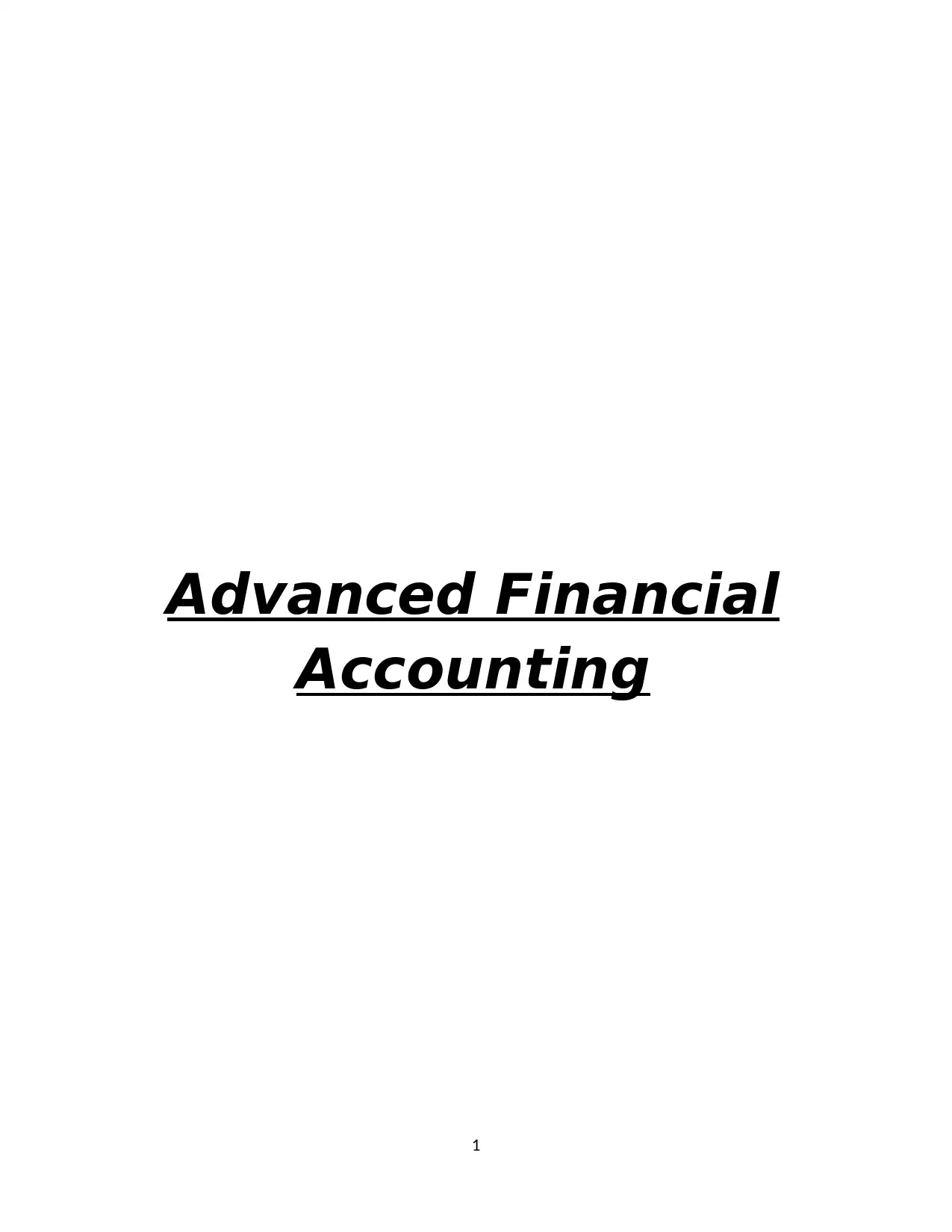
Advanced Financial
Accounting
1
Accounting
1
Paraphrase This Document
Need a fresh take? Get an instant paraphrase of this document with our AI Paraphraser
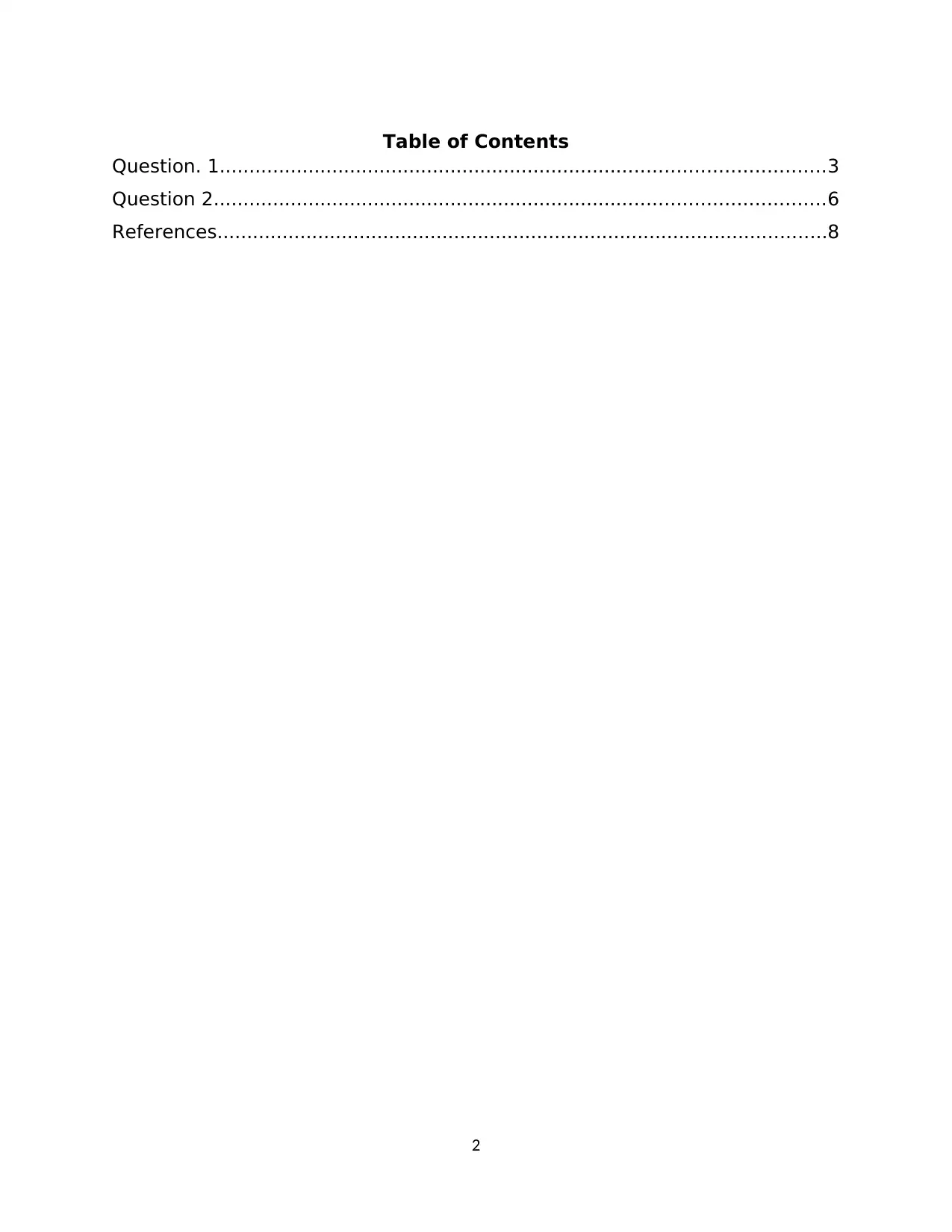
Table of Contents
Question. 1......................................................................................................3
Question 2.......................................................................................................6
References.......................................................................................................8
2
Question. 1......................................................................................................3
Question 2.......................................................................................................6
References.......................................................................................................8
2

Question. 1
MEMORANDUM
Date: 19 August 2019
To: Angela Kirk, CEO of Wakefield Ltd.
From: Mathew, Investment Consultant of Mercer
Subject: The accounting requirements for the proposed investment
Introduction
The main aim of this Memorandum is to explain the AASB 10 needs which
based on “Consolidated Financial Statements” under section 334 of the
Corporation Act, 2001.
Consolidated Financial Statements
The consolidated financial statements are the group statement in which the
income, expenses, assets, flows of cash and liabilities of the parent and its
subordinates shown as single entity statements (Bisogno, Santis, &
Tommasetti, 2015).
Objective
The foremost objective of this accounting standard is to make the standards
for creating and present the consolidated financial statements when a
company manage or controls one or more companies (Bini, 2019).
Meeting the objective
To achieve the objective of this standard following points should be
considered:
a. To present the consolidated financial statements, this standard requires a
company, i.e. parent company that manages and controls one or more
companies, i.e. subordinate companies;
b. This standard defines and establishes the control principle as the basis for
consolidation; and
c. This standard establishes requirements of accounting for the making of
consolidated financial statements.
Scope
3
MEMORANDUM
Date: 19 August 2019
To: Angela Kirk, CEO of Wakefield Ltd.
From: Mathew, Investment Consultant of Mercer
Subject: The accounting requirements for the proposed investment
Introduction
The main aim of this Memorandum is to explain the AASB 10 needs which
based on “Consolidated Financial Statements” under section 334 of the
Corporation Act, 2001.
Consolidated Financial Statements
The consolidated financial statements are the group statement in which the
income, expenses, assets, flows of cash and liabilities of the parent and its
subordinates shown as single entity statements (Bisogno, Santis, &
Tommasetti, 2015).
Objective
The foremost objective of this accounting standard is to make the standards
for creating and present the consolidated financial statements when a
company manage or controls one or more companies (Bini, 2019).
Meeting the objective
To achieve the objective of this standard following points should be
considered:
a. To present the consolidated financial statements, this standard requires a
company, i.e. parent company that manages and controls one or more
companies, i.e. subordinate companies;
b. This standard defines and establishes the control principle as the basis for
consolidation; and
c. This standard establishes requirements of accounting for the making of
consolidated financial statements.
Scope
3
⊘ This is a preview!⊘
Do you want full access?
Subscribe today to unlock all pages.

Trusted by 1+ million students worldwide
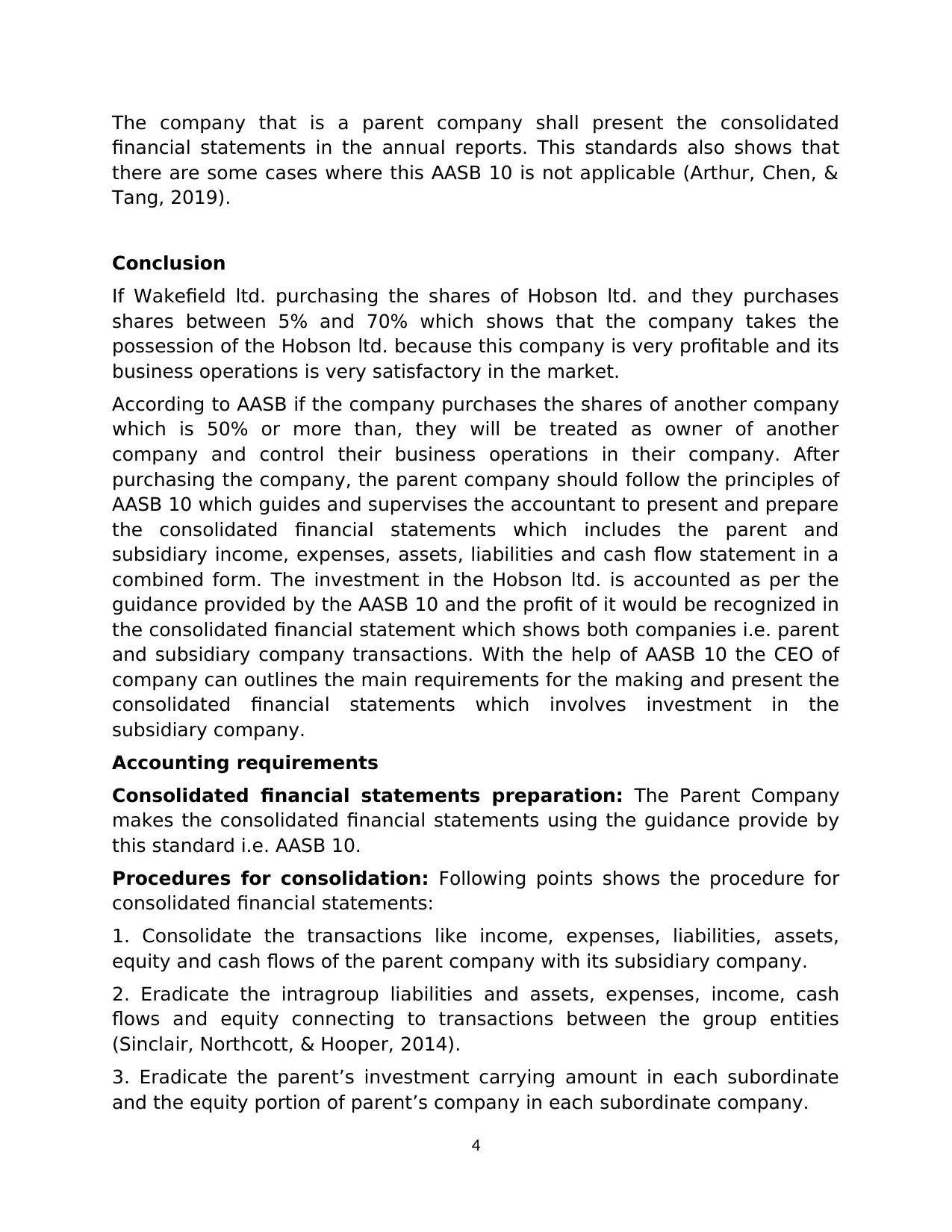
The company that is a parent company shall present the consolidated
financial statements in the annual reports. This standards also shows that
there are some cases where this AASB 10 is not applicable (Arthur, Chen, &
Tang, 2019).
Conclusion
If Wakefield ltd. purchasing the shares of Hobson ltd. and they purchases
shares between 5% and 70% which shows that the company takes the
possession of the Hobson ltd. because this company is very profitable and its
business operations is very satisfactory in the market.
According to AASB if the company purchases the shares of another company
which is 50% or more than, they will be treated as owner of another
company and control their business operations in their company. After
purchasing the company, the parent company should follow the principles of
AASB 10 which guides and supervises the accountant to present and prepare
the consolidated financial statements which includes the parent and
subsidiary income, expenses, assets, liabilities and cash flow statement in a
combined form. The investment in the Hobson ltd. is accounted as per the
guidance provided by the AASB 10 and the profit of it would be recognized in
the consolidated financial statement which shows both companies i.e. parent
and subsidiary company transactions. With the help of AASB 10 the CEO of
company can outlines the main requirements for the making and present the
consolidated financial statements which involves investment in the
subsidiary company.
Accounting requirements
Consolidated financial statements preparation: The Parent Company
makes the consolidated financial statements using the guidance provide by
this standard i.e. AASB 10.
Procedures for consolidation: Following points shows the procedure for
consolidated financial statements:
1. Consolidate the transactions like income, expenses, liabilities, assets,
equity and cash flows of the parent company with its subsidiary company.
2. Eradicate the intragroup liabilities and assets, expenses, income, cash
flows and equity connecting to transactions between the group entities
(Sinclair, Northcott, & Hooper, 2014).
3. Eradicate the parent’s investment carrying amount in each subordinate
and the equity portion of parent’s company in each subordinate company.
4
financial statements in the annual reports. This standards also shows that
there are some cases where this AASB 10 is not applicable (Arthur, Chen, &
Tang, 2019).
Conclusion
If Wakefield ltd. purchasing the shares of Hobson ltd. and they purchases
shares between 5% and 70% which shows that the company takes the
possession of the Hobson ltd. because this company is very profitable and its
business operations is very satisfactory in the market.
According to AASB if the company purchases the shares of another company
which is 50% or more than, they will be treated as owner of another
company and control their business operations in their company. After
purchasing the company, the parent company should follow the principles of
AASB 10 which guides and supervises the accountant to present and prepare
the consolidated financial statements which includes the parent and
subsidiary income, expenses, assets, liabilities and cash flow statement in a
combined form. The investment in the Hobson ltd. is accounted as per the
guidance provided by the AASB 10 and the profit of it would be recognized in
the consolidated financial statement which shows both companies i.e. parent
and subsidiary company transactions. With the help of AASB 10 the CEO of
company can outlines the main requirements for the making and present the
consolidated financial statements which involves investment in the
subsidiary company.
Accounting requirements
Consolidated financial statements preparation: The Parent Company
makes the consolidated financial statements using the guidance provide by
this standard i.e. AASB 10.
Procedures for consolidation: Following points shows the procedure for
consolidated financial statements:
1. Consolidate the transactions like income, expenses, liabilities, assets,
equity and cash flows of the parent company with its subsidiary company.
2. Eradicate the intragroup liabilities and assets, expenses, income, cash
flows and equity connecting to transactions between the group entities
(Sinclair, Northcott, & Hooper, 2014).
3. Eradicate the parent’s investment carrying amount in each subordinate
and the equity portion of parent’s company in each subordinate company.
4
Paraphrase This Document
Need a fresh take? Get an instant paraphrase of this document with our AI Paraphraser
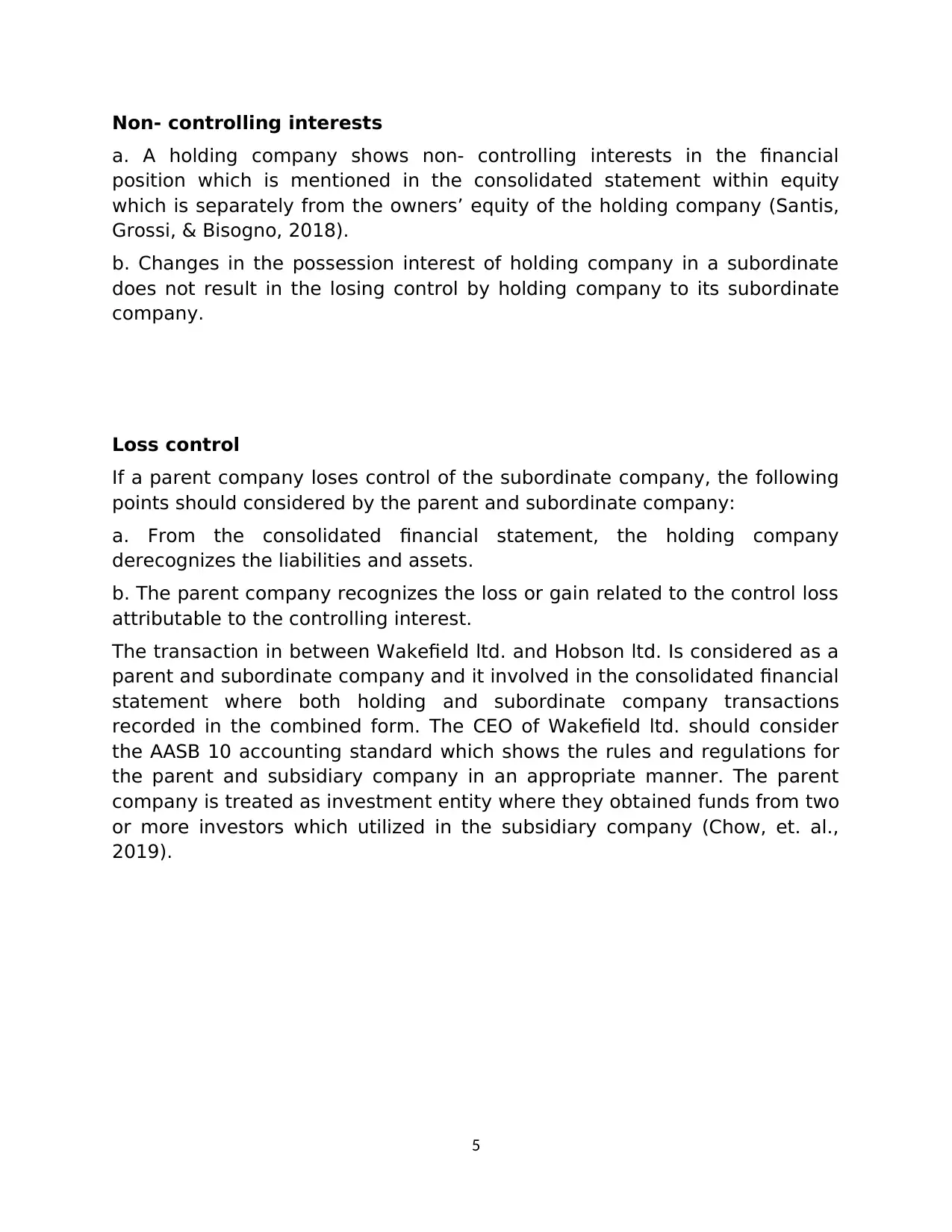
Non- controlling interests
a. A holding company shows non- controlling interests in the financial
position which is mentioned in the consolidated statement within equity
which is separately from the owners’ equity of the holding company (Santis,
Grossi, & Bisogno, 2018).
b. Changes in the possession interest of holding company in a subordinate
does not result in the losing control by holding company to its subordinate
company.
Loss control
If a parent company loses control of the subordinate company, the following
points should considered by the parent and subordinate company:
a. From the consolidated financial statement, the holding company
derecognizes the liabilities and assets.
b. The parent company recognizes the loss or gain related to the control loss
attributable to the controlling interest.
The transaction in between Wakefield ltd. and Hobson ltd. Is considered as a
parent and subordinate company and it involved in the consolidated financial
statement where both holding and subordinate company transactions
recorded in the combined form. The CEO of Wakefield ltd. should consider
the AASB 10 accounting standard which shows the rules and regulations for
the parent and subsidiary company in an appropriate manner. The parent
company is treated as investment entity where they obtained funds from two
or more investors which utilized in the subsidiary company (Chow, et. al.,
2019).
5
a. A holding company shows non- controlling interests in the financial
position which is mentioned in the consolidated statement within equity
which is separately from the owners’ equity of the holding company (Santis,
Grossi, & Bisogno, 2018).
b. Changes in the possession interest of holding company in a subordinate
does not result in the losing control by holding company to its subordinate
company.
Loss control
If a parent company loses control of the subordinate company, the following
points should considered by the parent and subordinate company:
a. From the consolidated financial statement, the holding company
derecognizes the liabilities and assets.
b. The parent company recognizes the loss or gain related to the control loss
attributable to the controlling interest.
The transaction in between Wakefield ltd. and Hobson ltd. Is considered as a
parent and subordinate company and it involved in the consolidated financial
statement where both holding and subordinate company transactions
recorded in the combined form. The CEO of Wakefield ltd. should consider
the AASB 10 accounting standard which shows the rules and regulations for
the parent and subsidiary company in an appropriate manner. The parent
company is treated as investment entity where they obtained funds from two
or more investors which utilized in the subsidiary company (Chow, et. al.,
2019).
5
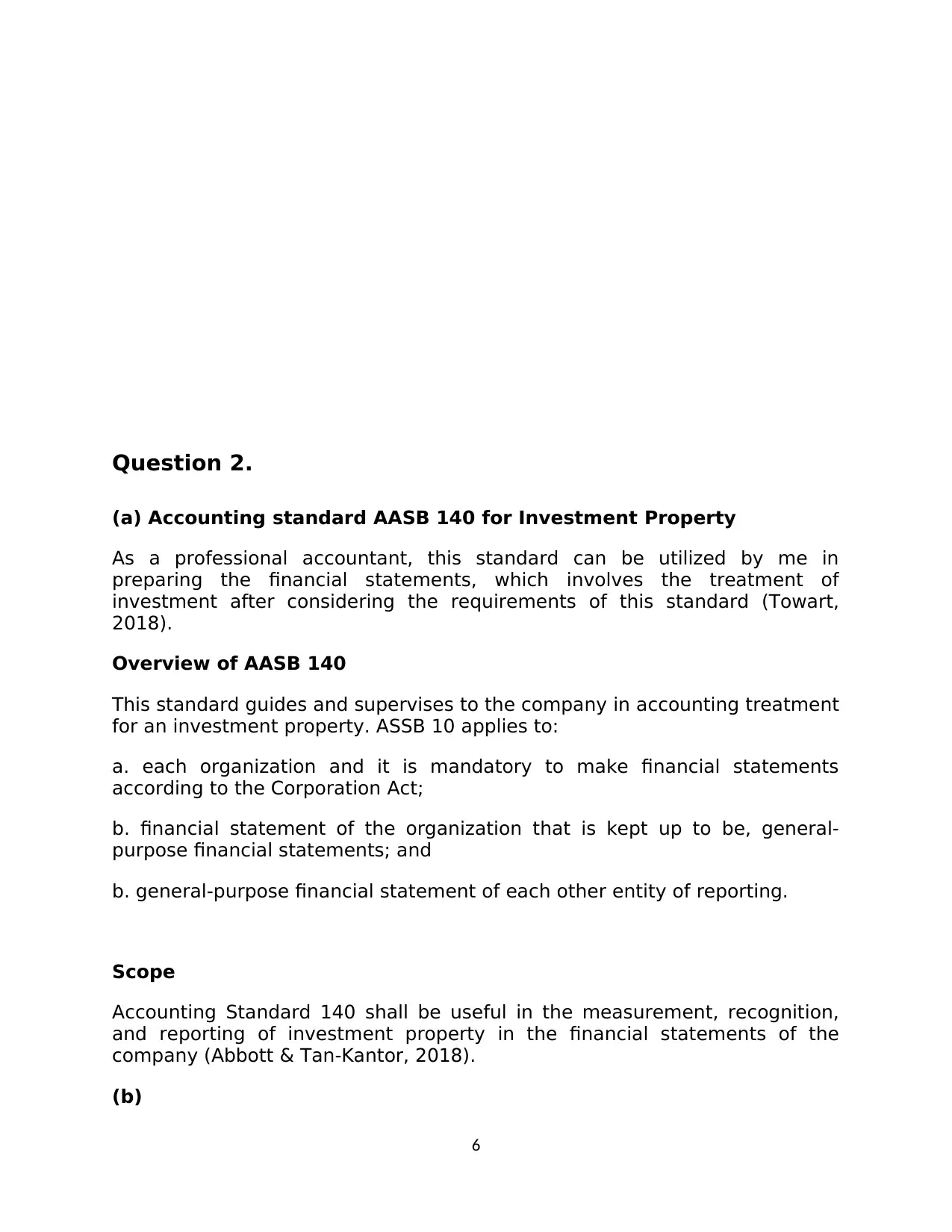
Question 2.
(a) Accounting standard AASB 140 for Investment Property
As a professional accountant, this standard can be utilized by me in
preparing the financial statements, which involves the treatment of
investment after considering the requirements of this standard (Towart,
2018).
Overview of AASB 140
This standard guides and supervises to the company in accounting treatment
for an investment property. ASSB 10 applies to:
a. each organization and it is mandatory to make financial statements
according to the Corporation Act;
b. financial statement of the organization that is kept up to be, general-
purpose financial statements; and
b. general-purpose financial statement of each other entity of reporting.
Scope
Accounting Standard 140 shall be useful in the measurement, recognition,
and reporting of investment property in the financial statements of the
company (Abbott & Tan‐Kantor, 2018).
(b)
6
(a) Accounting standard AASB 140 for Investment Property
As a professional accountant, this standard can be utilized by me in
preparing the financial statements, which involves the treatment of
investment after considering the requirements of this standard (Towart,
2018).
Overview of AASB 140
This standard guides and supervises to the company in accounting treatment
for an investment property. ASSB 10 applies to:
a. each organization and it is mandatory to make financial statements
according to the Corporation Act;
b. financial statement of the organization that is kept up to be, general-
purpose financial statements; and
b. general-purpose financial statement of each other entity of reporting.
Scope
Accounting Standard 140 shall be useful in the measurement, recognition,
and reporting of investment property in the financial statements of the
company (Abbott & Tan‐Kantor, 2018).
(b)
6
⊘ This is a preview!⊘
Do you want full access?
Subscribe today to unlock all pages.

Trusted by 1+ million students worldwide

Document No. 1
Name of document: AASB 140, Investment Property
Date: June 2014
Author: Government Authority
Link: https://www.aasb.gov.au/admin/file/content105/c9/AASB140_07-
04_COMPjun14_07-14.pdf
Document No. 2
Name of document: Accounting for owner-occupied property: goldmine or
landmine?
Date: 2008
Author: David Parker
Link:
https://www.finsia.com/docs/default-source/jassa-new/jassa2008/34_38_parker_jass
aiss2_2008_web.pdf?sfvrsn=87d7de93_6
(c) These two documents provide valuable and suitable information about
investment property accounting treatment in the financial statement of the
company. The document no. 1 includes information about the accounting
treatment of investment property in the financial statement of the company.
This document helps and guides the accountant in preparing the working
notes which is related to the AASB 140.
Whereas in document no. 2, there is a case study which was prepared by the
author related to the accounting for the owner-occupied property which
helps the accountant in the treatment of investment property. With the help
of these two documents, I can enhance my knowledge in this accounting
standard which can I utilize in the future as a position of accountant in the
company.
7
Name of document: AASB 140, Investment Property
Date: June 2014
Author: Government Authority
Link: https://www.aasb.gov.au/admin/file/content105/c9/AASB140_07-
04_COMPjun14_07-14.pdf
Document No. 2
Name of document: Accounting for owner-occupied property: goldmine or
landmine?
Date: 2008
Author: David Parker
Link:
https://www.finsia.com/docs/default-source/jassa-new/jassa2008/34_38_parker_jass
aiss2_2008_web.pdf?sfvrsn=87d7de93_6
(c) These two documents provide valuable and suitable information about
investment property accounting treatment in the financial statement of the
company. The document no. 1 includes information about the accounting
treatment of investment property in the financial statement of the company.
This document helps and guides the accountant in preparing the working
notes which is related to the AASB 140.
Whereas in document no. 2, there is a case study which was prepared by the
author related to the accounting for the owner-occupied property which
helps the accountant in the treatment of investment property. With the help
of these two documents, I can enhance my knowledge in this accounting
standard which can I utilize in the future as a position of accountant in the
company.
7
Paraphrase This Document
Need a fresh take? Get an instant paraphrase of this document with our AI Paraphraser
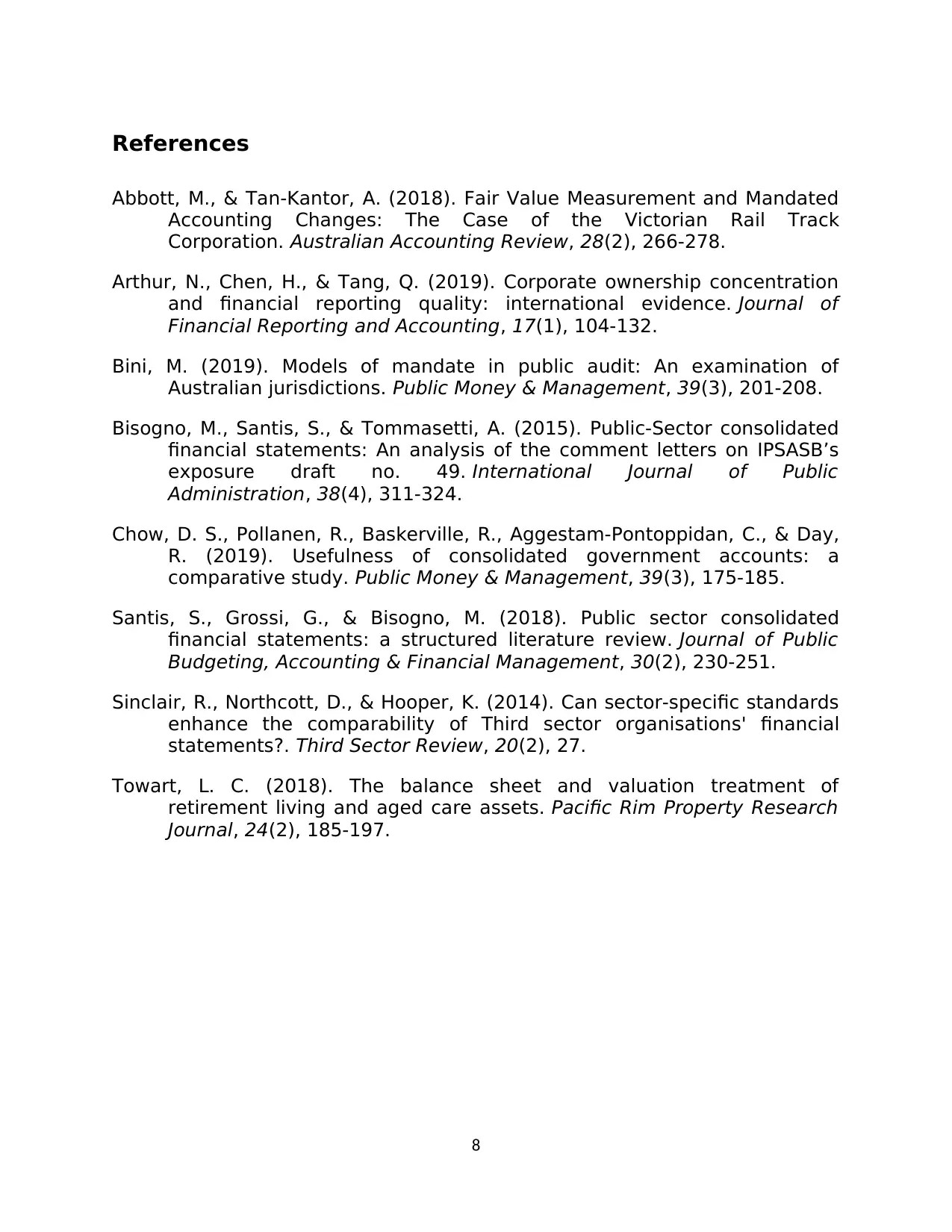
References
Abbott, M., & Tan‐Kantor, A. (2018). Fair Value Measurement and Mandated
Accounting Changes: The Case of the Victorian Rail Track
Corporation. Australian Accounting Review, 28(2), 266-278.
Arthur, N., Chen, H., & Tang, Q. (2019). Corporate ownership concentration
and financial reporting quality: international evidence. Journal of
Financial Reporting and Accounting, 17(1), 104-132.
Bini, M. (2019). Models of mandate in public audit: An examination of
Australian jurisdictions. Public Money & Management, 39(3), 201-208.
Bisogno, M., Santis, S., & Tommasetti, A. (2015). Public-Sector consolidated
financial statements: An analysis of the comment letters on IPSASB’s
exposure draft no. 49. International Journal of Public
Administration, 38(4), 311-324.
Chow, D. S., Pollanen, R., Baskerville, R., Aggestam-Pontoppidan, C., & Day,
R. (2019). Usefulness of consolidated government accounts: a
comparative study. Public Money & Management, 39(3), 175-185.
Santis, S., Grossi, G., & Bisogno, M. (2018). Public sector consolidated
financial statements: a structured literature review. Journal of Public
Budgeting, Accounting & Financial Management, 30(2), 230-251.
Sinclair, R., Northcott, D., & Hooper, K. (2014). Can sector-specific standards
enhance the comparability of Third sector organisations' financial
statements?. Third Sector Review, 20(2), 27.
Towart, L. C. (2018). The balance sheet and valuation treatment of
retirement living and aged care assets. Pacific Rim Property Research
Journal, 24(2), 185-197.
8
Abbott, M., & Tan‐Kantor, A. (2018). Fair Value Measurement and Mandated
Accounting Changes: The Case of the Victorian Rail Track
Corporation. Australian Accounting Review, 28(2), 266-278.
Arthur, N., Chen, H., & Tang, Q. (2019). Corporate ownership concentration
and financial reporting quality: international evidence. Journal of
Financial Reporting and Accounting, 17(1), 104-132.
Bini, M. (2019). Models of mandate in public audit: An examination of
Australian jurisdictions. Public Money & Management, 39(3), 201-208.
Bisogno, M., Santis, S., & Tommasetti, A. (2015). Public-Sector consolidated
financial statements: An analysis of the comment letters on IPSASB’s
exposure draft no. 49. International Journal of Public
Administration, 38(4), 311-324.
Chow, D. S., Pollanen, R., Baskerville, R., Aggestam-Pontoppidan, C., & Day,
R. (2019). Usefulness of consolidated government accounts: a
comparative study. Public Money & Management, 39(3), 175-185.
Santis, S., Grossi, G., & Bisogno, M. (2018). Public sector consolidated
financial statements: a structured literature review. Journal of Public
Budgeting, Accounting & Financial Management, 30(2), 230-251.
Sinclair, R., Northcott, D., & Hooper, K. (2014). Can sector-specific standards
enhance the comparability of Third sector organisations' financial
statements?. Third Sector Review, 20(2), 27.
Towart, L. C. (2018). The balance sheet and valuation treatment of
retirement living and aged care assets. Pacific Rim Property Research
Journal, 24(2), 185-197.
8
1 out of 8
Related Documents
Your All-in-One AI-Powered Toolkit for Academic Success.
+13062052269
info@desklib.com
Available 24*7 on WhatsApp / Email
![[object Object]](/_next/static/media/star-bottom.7253800d.svg)
Unlock your academic potential
Copyright © 2020–2025 A2Z Services. All Rights Reserved. Developed and managed by ZUCOL.





